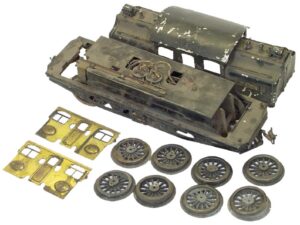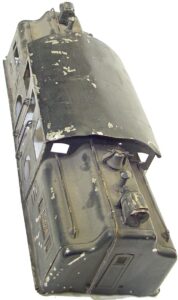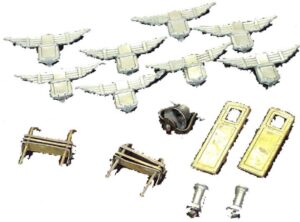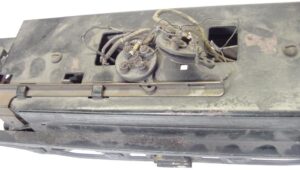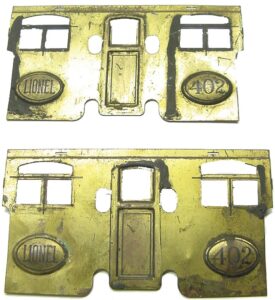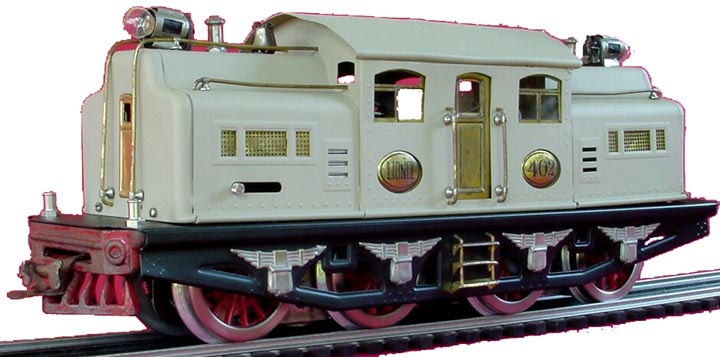Saved from the dumpster! The restoration of a Lionel 402 Engine.
by Mike Isenberg.
My wife, Kari, and I arrived early for the Sept. 14, 2002 Greg Stout live toy train auction in Indianapolis. We split up and did a quick once-over of the tables. Kari came and grabbed me; “You’ve got to see this!” she said. We walked to a side table and there in a box was the worst looking toy train lot I had ever seen. Scattered around were the remains of a hand reverse Standard Gauge prewar Lionel 402. I turned to her and said “what a pile of junk”! As I looked a bit more thoroughly, it seemed it was fairly complete. A rough shell with most of the trim, decent frame, both Super motors with two hand reversing units, and eight original wheels. (I later realized the wheels were for a steamer, so I ordered new wheels). Ages ago, someone had brushed a heavy and sloppy coat of flat black paint over everything, including the shell, Brass and Nickel trim. There were only two bidders and I bought it.
When we got home, I laid it out and photographed what I had. I started an ongoing posting to the online Yahoo Standard Gauge chat group, telling everyone what I was up to. I looked it over and thought about it for a couple of days before I did anything, other than place an order for parts. I had hoped to salvage the Mojave paint by stripping the black only. There was so much original paint chipped off, I decided to simply strip it down to the bare metal and live with a repaint. I removed all the trim, took the motors out of the frame, and went to work with Strypeeze. I stripped the shell and frame clean and set them aside to dry. I then used Strypeeze to strip all the trim. I was able to get the black stripped from the pilots and salvage some of the old red original Lionel paint, and left it. It blends well. It quickly became obvious to me how early toy trains picked up the name Tinplate. The steel sheet was so heavily Tin-plated, the clean shell looked chrome plated. I have read a good deal about Lionel’s early days, yet I had never read anything about spot welding being used in manufacturing. It certainly was here, there are four heavy spot welds holding the side frames to the motor housing. These show clearly in the photo of the stripped frame.
There was one solder seam popped open on the shell that had to be dealt with. As I have no experience with soldering sheetmetal, I decided to repair that with J&B Weld, a very strong epoxy containing ground steel. To pull everything into alignment all at once, I used woodworking clamps, called handscrews, to gently clamp it in one direction. I then used heavy nylon twine to pull tension on another direction. That done, I still had a twist to pull out before I could apply J&B. I set it all up vertically and weighted it, and that did it. I applied a heavy bead of J&B Weld and walked away from it. When that was thoroughly dry, I used my hands to straighten out all the dings and dents in the shell. The shell showed much rough handling, I am convinced this electric had been relegated to a simple floor/sidewalk pull toy and was played with hard. There really wasn’t much wear to the bushings or commutators, I seriously doubt this engine had ever ran under power in it’s life!
I now primed both the shell and frame. I thought about what to paint the shell. As this was never going to be a high-grade piece, I considered a more colorful paint scheme, two tone State Brown? Copper and Cream? Hiawatha Orange? Guess not, as all production 402s are Mojave and this one was, under the filth and black, I decided to be a faithful as possible to the original. Shiny new paint was going to magnify all the dings, so I found an alternative. I bought a sand color (almost Mojave) Krylon matte paint intended for camouflage of waterfowl hunting gear. I like the matte finish, even though it’s not original. I then painted the frame a satin black & called it all painted. As parts started to trickle in, I next tackled the Super motors. There was almost no insulation left on the wiring and it all had to be replaced. When disassembled, the motors were surprisingly free of damage. I simply cleaned them thoroughly, lubed and reassembled them. Getting the motors back together with the awkward brush arrangement was the biggest trick. The seventy-five year old brush springs surprised me, tremendous strength to all four.
I was concerned about damaging the heavy brass door and window inserts by over polishing them. At this point, all I’ve done is a minimal paint removal and polishing. Next, I replaced handrails, ventilator grills, lights, whistles and bell, and a repo pantagraph. I had to make two handrails from brass rod. To get the radius of the bends correct, I tightened a 7/16″ drill bit in a vise and used the smooth end of the bit to bend the rod. I have no doubt there will be more sessions of fine tuning to get it as right as possible.
I want to add a “Thank You” to everyone on the Yahoo list for their tips and encouragement. I really wasn’t sure anyone else would be interested in what I was up to, but it turns out that there was a quite a bit of interest.
Soon this Lionel 402 will be pounding down the track on my SG layout pulling an early consist, as JLC meant it to. I feel very gratified to have saved this one from the dumpster!

